
NLR 7301 Multi-Element Airfoil Calculation
Multi-element airfoils are common sights on open-wheel racing cars and aircraft during take-off and landing.
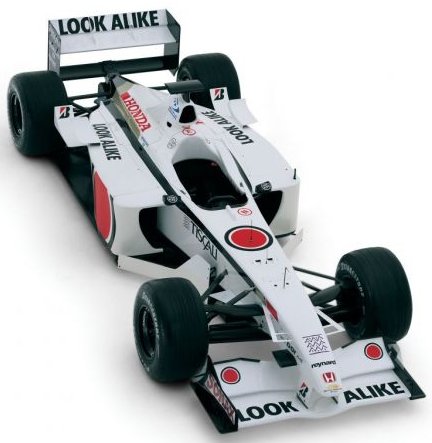 Honda Formula 1 Car: Multi-element airfoils at front and rear
Honda Formula 1 Car: Multi-element airfoils at front and rear
Background
The main benefit of a multi-element airfoil configuration over a single airfoil is increased lift or downforce for the same angle of attack (alpha). Motor racing uses multi-element airfoils because they are relatively compact compared to the equivalent single airfoil for the same downforce. Aircraft deploy multi-element airfoils to augment the lift from their primary airfoil during relatively slow speed maneuvers such as take-off and landing.
One such multi-element airfoil is the NLR 7301 with trailing edge flap which has well regarded 2D wind-tunnel data (by Van Den Berg and Gooden) with pressure-coefficient distributions at alpha = 6 and 13.1 degrees. Calculations from our inviscid Panel Flow add-on should match the experimental data where viscous effects are negligible and so this is a good case to examine strengths and weaknesses of an inviscid technique.
Method
To simulate 2D airfoils in our 3D simulation, the 2D airfoil sections were extended 20 chord lengths in the span-wise direction using our Builder add-on. Symmetry was also enabled, effectively doubling the span to 40 chord lengths. All data were extracted on the symmetry plane to maximize the distance to the ends and thus minimize end effects on the extracted data.
We performed calculations at alpha = 6 and alpha = 13.1 degrees for which there are experimental pressure-coefficient distributions. The alphas for both cases were specified as linear velocities, i.e., Vx = cos(alpha), Vy = sin(alpha), rather than rotating the geometry as in a previous example.
Wakes were specified originating at the airfoil trailing edges. An automated, pseudo time-stepping, force-free technique was used to convect wake elements downstream.
Surface pressure coefficient contours and wake elements for alpha = 6 are shown below.
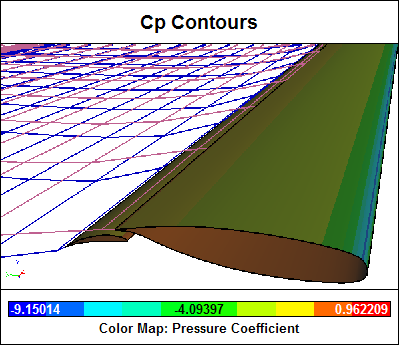
Results
The combined pressure-coefficient distribution at alpha = 6 for both the main airfoil and the flap is shown below.
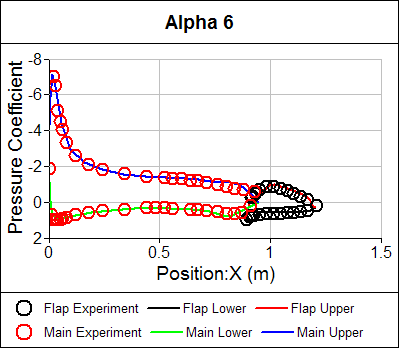
A detailed view of the pressure-coefficient distribution for the main airfoil at alpha = 6 is shown below. Note the good agreement between the experiment and the calculation.
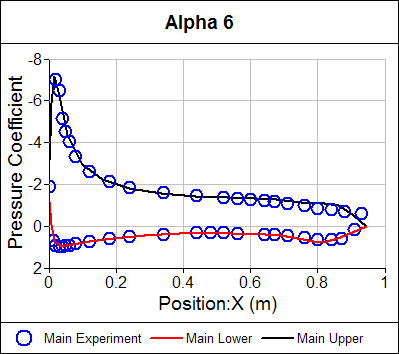
A detailed view of the pressure-coefficient distribution for the flap at alpha = 6 is shown below. Notice reasonable agreement between the experiment and our calculation. Discrepancies are most likely due to un-modeled viscous effects in the vicinity of the flap.
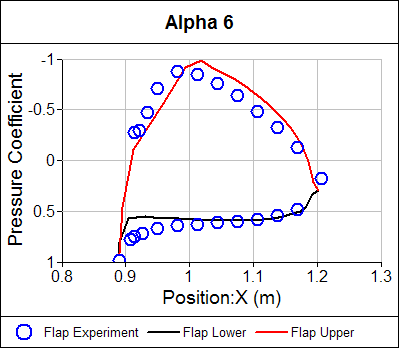
The combined pressure-coefficient distribution at alpha = 13.1 for both the main airfoil and the flap is shown below.
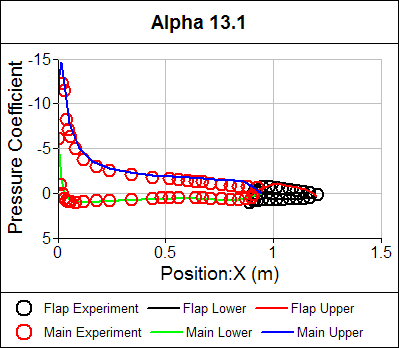
This condition is likely close to stall and therefore viscous effects are significant, thus we shouldn't expect accurate predictions with our inviscid calculation.
A detailed view of the pressure-coefficient distribution for the main airfoil at alpha = 13.1 is shown below. Note the reasonably good agreement between the experiment and the calculation. The suction peak on the airfoil is over predicted due to neglecting viscous effects.
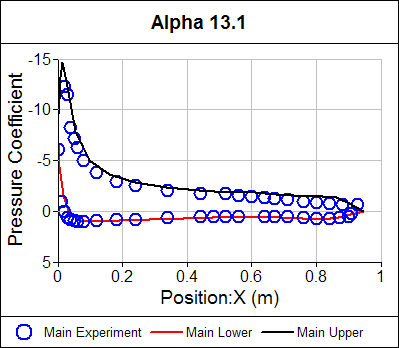
A detailed view of the pressure-coefficient distribution for the flap at alpha = 13.1 is shown below. Notice reasonable agreement between the experiment and our calculation. Discrepancies are most likely due to un-modeled viscous effects in the vicinity of the flap.
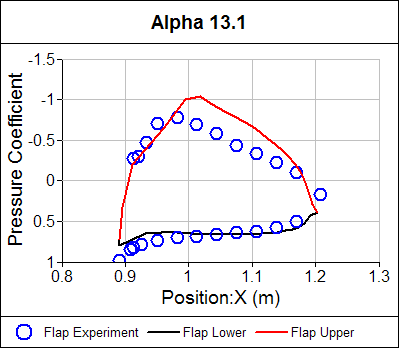
Try For Yourself
The two sym projects files (alpha = 6 and alpha = 13.1) for this study can be viewed in Caedium or you can investigate these cases yourself using our Panel Flow add-on.
The most convenient way to view and edit these cases is to use our Professional add-on that combines all the add-ons used during this example.
- Login to post comments

